Welcome to Gujarat Tourism
Ahmedabad - Dwarka - Somnath
GUJARAT
If you are dreaming of a vacation in paradise, Gujarat welcomes you – the land of rich history with culture, tradition and heritage. Gujarat is the 7th largest state in India, located in the western part of India.
Gujarat is home to several architectural marvels and is famous for its vibrant culture and rich heritage, apart from the scenic landscapes and mouth-watering cuisine. Offering a broad range of the most spectacular attractions, Gujarat, also known as 'The Land of Legends', presents a perfect blend of art, history, music and culture
The vibrant Indian state Gujarat is the most attractive tourist destination for international and domestic travelers. You could travel to the incredible state of India for many reasons. The state is blessed with the diverse attractions such as historical monuments, world famous architecture, temples and exotic wildlife. Come and get lost in ‘Khusboo Gujarat ki’.
Being the sole home of the pure Asiatic Lions, Gujarat also offers splendid views of the scenic beauty ranging from the Great Rann of Kutch to the hills of Satpura.Apart from the picturesque landscapes and the more than 1600 kilometres long coastline, Gujarat also offers its tourists with some magnificent ancient cave paintings, historic murals, holy temples, historic capitals, wildlife sanctuaries, beaches, hill resorts and fascinating handicrafts. Gujarat is a dry state but the cultural exuberance of the Gujratis will give rejuvenate you.
ITINERARY :AHMEDABAD-JAMNAGAR-DWARKA-SOMNATH (6 Days/5 Nights)>>
- No of Days: 6 Days
- Package Cost : 600Euros
- Distance & Hours: 964kms - 16 hours
- Tour Starts by : 06:00 am
DAY-1 : Ahmedabad
Adalaj StepwellModheraPatanSidhpur |
DAY-2 : JamnagarAmd-Jam-315km-6hrs
DAY-3 : DwarkaJam-Dwarka-150km-3hrs
|
DAY-4 : Dwarka-PorbandarDwarka-Por-75km-1.5hrs
DAY-5 : Porbandar-SomnathPor-Som-200km-4hours
|
AHMEDABAD
Ahmedabad is one of the most important cities in Gujarat. Located on the banks of the Sabarmati River, Ahmedabad is the former capital of Gujarat, and its delicious food, colourful culture is making it a fast-growing tourist destination. The historic city of Ahmedabad or the old part of the city was declared as the UNESCO World Heritage Site.
Home to a plethora of remarkable temples like Swaminarayan Temple, intriguing museums and classy markets, with a little bit of colonial history attached to it, Ahmedabad is an excellent example of how a city can still retain every bit of its old-world charm while still rapidly progressing on the path of globalisation.
Ahmedabad is famous for its textiles and its tie-dye bandhani handloom technique, which makes it a great place to shop. From bandhani sarees, dupattas to traditionally embroidered dress materials, and other local handicrafts.
Sabarmati Ashram, situated directly beside the Sabarmati river, is a quaint and peaceful ashram built by Mahatma Gandhi after he returned from South Africa. To this date, Gandhiji’s living quarters are preserved here and is now used as a museum where visitors can learn all about his life and his teachings. The infamous Dandi Salt March, which was a crucial point in India’s independence struggle, originated from this ashram.
Places to Visit in Ahmedabad with Short Descriptions
Adalaj Stepwel
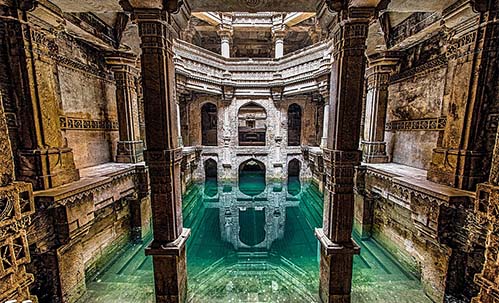
Set in the quiet village of Adalaj, this vav has served as a resting place for hundreds of years for many pilgrims and caravans along their trade routes. Built in 1499 by Queen Rudabai, wife of the Vaghela chief, Veersinh, this five-storey stepwell was not just a cultural and utilitarian space, but also a spiritual refuge. It is believed that villagers would come everyday in the morning to fill water, offer prayers to the deities carved into the walls and interact with each other in the cool shade of the vav. There is an opening in the ceilings above the landing which allows the light and air to enter the octagonal well. However, direct sunlight does not touch the flight of steps or landings except for a brief period at noon. Hence some researchers say that the atmosphere inside the well is six degrees cooler than the outside.
Another remarkable feature of this stepwell is that out of the many stepwells in Gujarat, it is the only one with three entrance stairs. All three stairs meet at the first storey, underground in a huge square platform, which has an octagonal opening on top. The vav is a spectacular example of Indo-Islamic architecture and design. The harmonious play of intricate Islamic floral patterns seamlessly fusing into Hindu and Jain symbolism embody the culture and ethos of those times. All the walls carved by ornamentation, mythological scenes along with everyday scenes of women churning buttermilk, dancers accompanied by musicians, women adorning themselves and a king sitting on a stool. Fascinating to many visitors is the Ami Khumbor (a pot that contains the water of life) and the Kalp Vriksha (a tree of life) carved out of a single slab of stone. There is a belief that the small frieze of navagraha (nine-planets) towards the edge of the well protects the monument from evil spirits.
Sun Temple
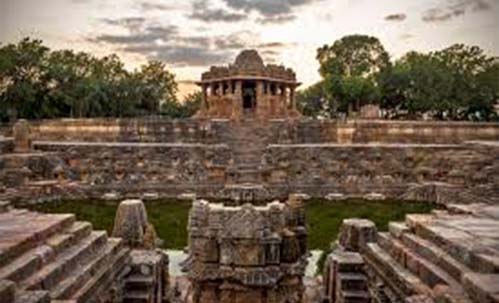
The precision of this jaw-dropping structure of Modhera and the hard work of the thousands behind it is going to leave your mind surprised. And it'll also leave you anguished when you realise that all these majesties were plundered with one stroke of destruction by Mahmud Ghazni. Standing at this moment, the temple of Modhera is just another magnificent ruin; an enigma that is lost in time. Built on the bank of Pushpavati river, the Modhera Sun Temple, today, stands as an obsolete temple where no worship is offered anymore. And you'll be shocked to know that this extraordinary piece of art was crafted even before the Konark Temple of Orissa.
The whole temple is pillared on a lotus-shaped structure and every inch of its walls showcase edgy, detailed carvings. And those carvings represent every bit of our culture: from Ramayana to Mahabharata, from the human lifecycle to Kamasutra. And the entire temple is expertly divided into three segments. The Surya Kund, which is a deep, stepped tank right in the front of the temple, was earlier used to store pure water. Although there is nothing more than accumulated rainwater presently, it is believed that earlier there used to be an underground spring. The assembly halls or sabha mandapa used to be the place for religious gatherings and conferences. Essentially built for the pilgrims, this place even had slabs constructed along the walls for them to sit and rest. Finally, you can reach guda mandap or the sanctum sanctorum by crossing the passage with pillars and arches. Once, this hall used to bear the idol of the Sun God before being plundered by Mahmud Ghazni. Still one can see the twelve different facets (for each month) of the Sun God on its walls. Mythologically speaking, the walk from the kund to guda mandap via the main temple is observed as the transcending journey from death to moksha. It's mesmerising.
The Modhera Temple was constructed under the reign of King Bhima I of the Chalukya dynasty. Created back in the early 11th century, Modhera has literally been mentioned on the history pages of Skanda & Brahma Puran. Even mythologically, Modhera and its surrounding areas have been referred to as Dharmaranya or the forest of righteousness. On top of that, this place was also blessed by Lord Rama. At present, the temple is undertaken by the Archaeological Survey of India for renovation and restoration. In 2014, this Modhera Sun Temple was added to the list of UNESCO World Heritage Sites.
Modhera Temple and its dedication to the Sun God will leave you stunned. - The temple was so constructed that during every equinox, the first sunrays would fall on a diamond placed on the Sun God's head. And the entire temple would illuminate in a golden glow. - On other days, two pillars before the garbhagriha would stay illuminated throughout the day, regardless of the position of the sun. All of these can only be left to imagination now. However, - the sabha mandap still stands on 52 pillars, depicting the 52 weeks in a year. - carvings of the sun, along with its unity with the other 4 elements-air, water, earth and space- can be spotted on the walls.
Rani Ki Vav
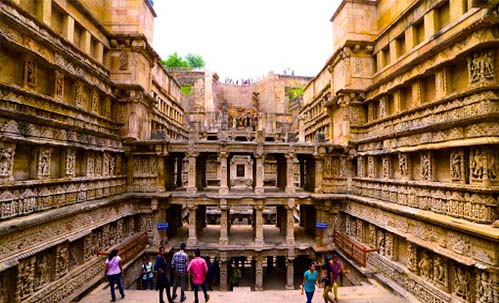
Rani Ki Vav or 'Queen's Stepwell' is a distinctive form of water storage system located in the small town of Gujarat called Patan, on the banks of River Saraswati. Believed to be the grandest stepwell in the state of Gujarat, Rani ka Vav epitomises the peak of Maru-Gujarat architectural style. The 900-year-old structure listed as a UNESCO World Heritage Site is displayed prominently in the new ₹ 100 currency note issued by the Reserve Bank of India.
The unique stepwell was constructed from 1063 to 1068 AD in Chalukya Dynasty as a memorial of Bhimdev Solanki by his widowed Queen Udaymati. It is designed in the shape of an inverted temple, divided into seven levels, highlighting the sanctity of water. Apart from being a water storage system, Rani Ki Vav is also known for its intricately carved sculptures on pillars that numbers around eight hundred primarily based on the theme of Lord Vishnu.
In the olden days, the water of the well had medicinal properties which helped ward off diseases like viral diseases and fever. The well was excavated in the 1960s in a well-protected state as it was buried under slit for sanctuaries. In addition to this, Rani Ka Vav was an important centre for socializing among the locals as well as taking refuge from the heat. It's an excellent example of turning something functional into a piece of art.
Sahastralinga Talav
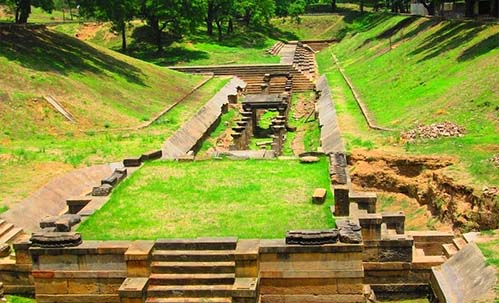
Situated in the north-west of Patan, Sahastralinga Talav is an artificial water storage tank constructed by the Chalukyan king Sidharaj Jai Singh in the late eleventh century. The tank gets water supply by a channel from river Sarasvati. Back then the tank would be brimming with water, the architectural design of the tank is praised for being the perfect amalgamation of design for water conservation and also reflection of the Hindu spirituality.
It is said that due a curse by a beautiful woman from the tank diggers community, the king died without an heir and the tank remains devoid of water ever since. It is said that there existed a lot of shrines dedicated to various gods and goddesses by the side of the tank, today however, there are just remains. When you visit the place, make sure you read the tourism boards and listen to the version of the locals to know about the stories which do the roundabout this place.
Patan Patola Heritage Museum

Patan Patola Heritage is a small private museum located in Patan, Gujarat. Situated near Patan City Museum, it is one of its kinds in the world and among the best places to visit in Patan. Run by the award-winning Salvi family, Patan Patola Heritage Museum came into existence in 2014. Over 3,000 sq. ft of space and three floors, it documents the history of the Patan Patola, a textile that combines techniques of tyeing, dyeing, and weaving. Worn by royals and aristocrats on auspicious occasions, and prized as a holy cloth even in South-east Asia, the Patola finds mention in the 14th century travel accounts of Ibn Batuta, who gifted Patolas to kings. These sarees were also mentioned in the 'Kalpsutra', a 2000-year-old Jain holy book.
This museum is an excellent place to see Patola silk weaving in action as it is the house-cum-studio-workshop of a family of master-weavers called the Salvis. The family has specialized in double-ikat weaving since the 11th century over roughly 35 generations. The museum showcases the live demonstration of a Patola saree being woven, get an understanding of the process, photographs of celebrities wearing the Patan Patola, old vegetable dyes, old saris woven by the family, a 200-year-old red Patola frock for a child, Ikat artifacts from other countries, the Salvi family history, and also numerous national awards that the family has won.
The making of Patan Patola sarees is extremely laborious and requires anywhere between five months to one year to create a single saree. Four to five family members work in unison, delicately weaving the unique creation. Another feature of these hand-dyed patolas which makes them stand out is that the feel and look of the fabric are exactly the same from both sides. In the 1930s, the Patola saree costs Rs. 120. Today, the simpler versions of double Ikat saree starts from 20,000 and goes up to several lakhs depending on the work done and thread used.
Bindu Sarovar
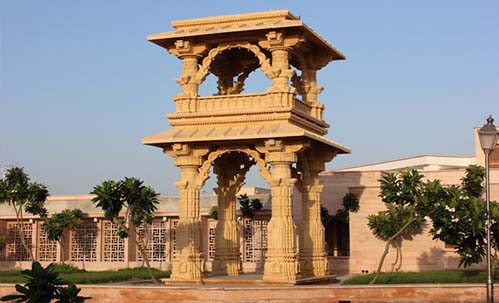
Bindu means a drop. Here drop has a divine reference as it refers to drop of tears of Lord Vishnu. Those drops of tears are being gathered in the pond named as Bindu Sagar or Bindu sarovar. This Bindu Sarovar is situated in Sidhpur of Gujarat. This is one of the Pancha Samovars considered as sacred theerthas in Hindu scripts. The other four are Manasa Sarovar in Tibet, Pushkar Sarovar in Rajasthan, Narayana Sarovar in Gujarat and Pampa Sarovar in Karnataka.
The Bindu Sarovar is an ancient stepwell located in the Matru Tarpan Place here. It is one of five most holy and ancient lakes in India. The sarovar is mostly visited by people who want to perform the last rites of their mothers. Bindu Sarovar is one of the most flocked spots for doing "Pind daan", a Hindu practice which is done to ensure that the ancestors rest in peace. According to Hindu tradition, Siddhpur, also known as Matrugaya Tirth is famous as a place where a son can repay his debt towards his mother.
Rudra Mahalay Temple
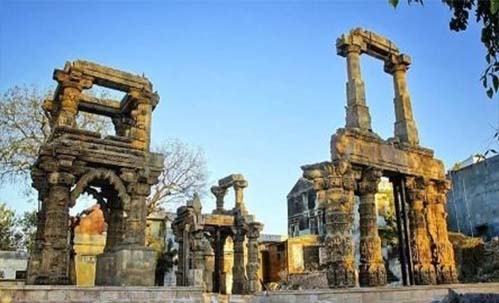
Another popular temple in Siddhpur is the Rudra Mahalaya Temple, also known as the Rudramal Temple. This temple was built in the 10th century by king Mularaja. According to legends, it was probably reconstructed by Siddharaja Jayasimha in the 12th century. The temple is said to be the first and largest Chalukyan temple. A multi-storeyed structure, it has 11 subsidiary shrines that are dedicated to Ekadasa Rudras. Excavations have revealed a few of these subsidiary shrines, a torana, two porches and four pillars of the main temple kapilli. Alongside were found beautifully carved gigantic columns, huge architraves and torana arches. The pillars and the toran stand as the remains of the temple today. The elaborate and detailed carvings on them are testament to the rich past of the rulers of Siddhpur.
Shree Umiya Mata Temple
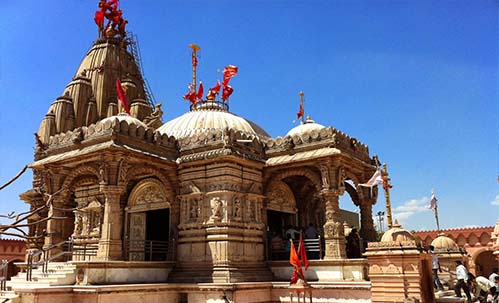
The temple worships Maa Oomiya, family Goddess to many Gujarati families and gotras. This temple is located in Unjha a city known for manufacturing cooking spices like Hing, Jeera, Mouth Freshning variyali etc.You find the best quality of these spices cheaper there due to manufacturing and wholesale base. The temple is full of bhakti.
JAMNAGAR
With exquisite examples of Rajput architecture and a prominent pearl fishing center, Jamnagar is Gujarat‘s lesser-known gems. Built around the Lakhota Lake, the city was the capital of the former state of Nawanagar, founded by Jam Raval in 1540 AD near the point where the Nagamati River and the Rangmati River meet. It was later rechristened as Jamnagar.
Jamnagar underwent a transformation when the then ruler in consultation with Sir Edward Lutyens, the architect of New Delhi, planned to modernize it. The new plans were based on modern design elements like axial road, entrance gates, parks, gardens and residential plots. Until recently manufacturing brass utensils was the biggest profession in Jamnagar and was therefore called the Brass City of India. However the city is booming today not because of the metal but rather the huge oil refinery owned by Reliance Petroleum.
Places to Visit in Jamnagar with Short Descriptions:
Lakhota Lake
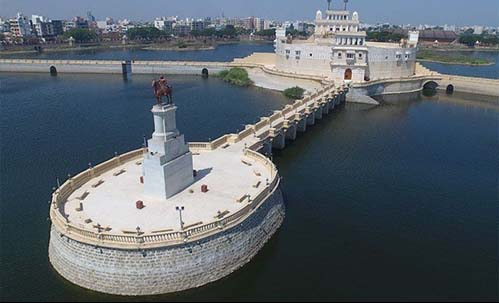
Lakhota Talav is one of the most beautiful and serene places of Jamnagar. Being right in the middle of the hustle and bustle of the city, the lake stands as the perfect picture of serenity. It is also known as the Ranmal Lake and surrounds Lakhota Fort, which is situated in an island inside. The lake and the palace were constructed by King of Navanagar, Jan Ranmal II in the mid-19th century AD. Within the palace, there is an archaeology museum which possesses sculptures (dating from 9th to 18th century), arms and firearms, medieval age pottery from surrounding villages and so on. The fort is connected with the banks through two pathways.
Birdwatching – Around 75 species of resident and migratory birds, such as flamingos, gulls, pelicans, spoonbills, have been observed to be the regular avian visitors. To get the best birdwatching experience, visit the place during the migration period. Boating in the Lakhota Lake & Visit Lakhota Palace and Museum.
Ranmal Lake is a major place of recreation for locals and a must-visit tourist spot. Evening is the time when most people come to socialise and relax. The lake being lit at night makes the whole place more attractive. Several food stalls are there to satisfy your hunger and make your taste buds happy. A walking track has been built around the lake to give the pleasure of walking round the lovely lake. There are benches around the Lakhota Lake to sit and relax; one can also sit and relax in the Kamala Nehru Park located near one end of the Talav.
Lakhota Lake
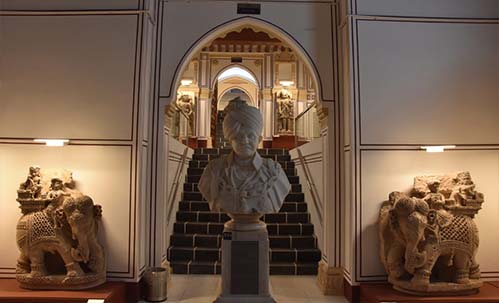
Lakhota Palace, a pleasing palace in the middle of the lake, houses a beautiful repository called Lakhota Museum. Rulers of Nawangar constructed the Lakhota Palace and today it is an important attraction of Jamnagar. The museum showcases the artefacts that belong to the 18th and 19th century including items like a skeleton of a whale, swords, powder flasks, possessions of Jadeja Rajputs, and remnants of Gujarat rulers. Also, there are artefacts describing the life of the people around the region who lived there during the 18th century. Lakhota Museum walls are covered with frescos and paintings depicting various wars that were fought by the Jadeja Rajputs. For those who want to see more of wonderful antiques can visit the Lakhota Palace. Beautiful ambience and palaces are something that shouldn't go unnoticed.
Bala Hanuman Temple
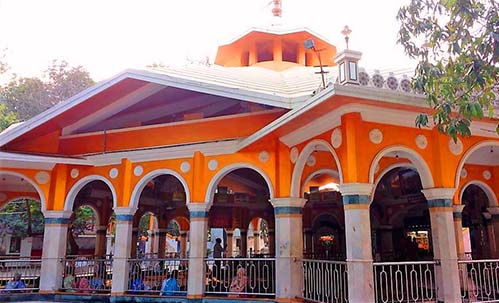
Bala Hanuman Temple, also known as Shri Balahanuman Sankirtan Mandir is situated at the south east side of Ranmal Lake (or Lakhota Lake) in Jamnagar. Dedicated to Lord Hanuman, the temple is separated from the lake by a wide road. The simple looking structure houses the idols of Lord Ram, Lord Lakshman, Goddess Sita and Lord Hanuman. Since 1st August, 1964, chanting of Ram dhun – 'Shri Ram, Jai Ram, Jai Jai Ram' goes on in the temple premises, day in and day out. This 24x7 ritual has been acknowledged and listed by the Guinness Book of World Records. Local population has deep faith in the temple and believes that it guards them from natural calamities and other troubles. Arti (ritual of worship) takes place twice in a day (morning and evening). The evening arti is the most awaited event of the day.
DWARKA
Located on the western tip of the Saurashtra peninsula in Gujarat, Dwarka is an ancient city of India. Known as Devbhoomi Dwarka, Dwarka boasts of being the only city that is a part of both Char Dham (four principal holy places) and also Sapta Puris (seven sacred cities) mentioned in the Hindu religion. Dwarka was a part of the ancient kingdom of Krishna and Nageshwar Jyotirlinga Temple, one of the 12 Jyotirlingas, is also located in Dwarka. For these reasons, it enjoys a remarkable religious significance and attracts thousands of pilgrims all year round. The beachside and the seashores are an added tourist attraction. Legend has it that the city was once engulfed by the sea and recent excavations reveal that a city did exist here. The name Dwarka translates to dwar meaning 'door' and ka meaning 'moksha' meaning the ‘door to salvation.
Places to Visit in DWARKA with Short Descriptions:
Dwarkadhish Temple
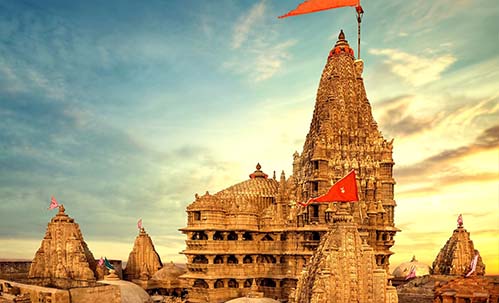
Lord Sri Krishna temple in Gomati coast is holy, which temple is known as DWARKADHISH Temple. According to the opinion of the Department of Archaeology, This temple is 1200 years old. Logically estimated one great-grandson of Lord Sri Krishna Vajranabhe Earlier, around 1400 BCE samudrama dubhi surviving remnant of the house of umbrellas established.
The main temple at Dwarka, situated on Gomti creek, is known as jagat mandir (universal shrine) or trilok sundar (the most beautiful in all the three worlds). Originally believed to be built by Vajranabh, the great grandson of Lord Krishna, more than 2500 years ago, it is a glorious structure seeming to rise from the waters of the Arabian Sea. Its exquisitely carved shikhar, reaching 43 m high and the huge flag made from 52 yards of cloth, can be seen from as far away as 10 km. The grandeur of the temple is enhanced by the flight of 56 steps leading to the rear side of the edifice on the side of the river Gomti. The temple is built of soft limestone and consists of a sanctum, vestibule and a rectangular hall with porches on three sides. There are two gateways: swarga dwar (gate to the heavens), where pilgrims enter, and moksha dwar (gate to liberation), where pilgrims exit.
Rukmini Devi Temple
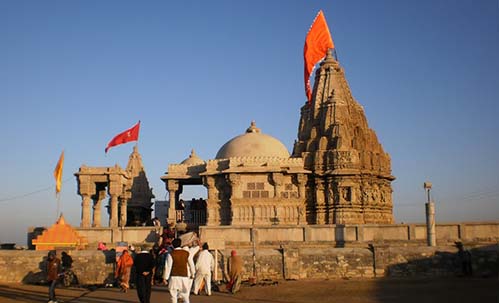
Rukmini is the reigning queen of Dwarka and Dwarkasdhish. Your visit to the city is not complete till you visit her too.
Nageshwar Jyotirling
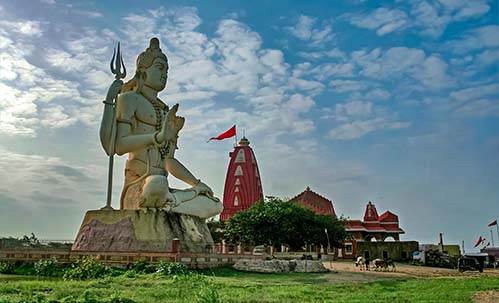
Nageshwar Temple situated in Dwarka is one of the 12 Jyotirlingas in India. It is located on the route between Gomati Dwarka and the Bait Dwarka Island on the coast of Saurashtra in Gujarat. Also sometimes known as Nagnath Temple, the main deity here is Lord Shiva, also known as Nageshwar Mahadev. According to the Shiva Purana, those who pray at the Nageshwar Jyotirlinga become free from all poisons, snake bites and worldly attractions.
Unlike other Nageshwar Temples, the statue or the Linga here faces south. A major highlight of Nageshwar Temple is the massive 80 feet tall statue of Lord Shiva. The temple itself is characterised by typical Hindu architecture. The Nageshwar Shiva Linga is made up of stone, known as Dwarka Shila, having small chakras on it. It is in the shape of 3 mukhi Rudraksha.
The importance of Nageshwar Jyotirlinga stems from the fact that it is believed to be the first of the 12 Jyotirlingas in India. Designed on the principles of Vaastu Shastra, the temple is planned on the Sayanam (sleeping) posture of the human body. On the festival of Maha Shivaratri, the Nageshwar Jyotirlinga Temple witnesses grand celebration, drawing flock of devotees from all across the globe.
Beyt Dwarka
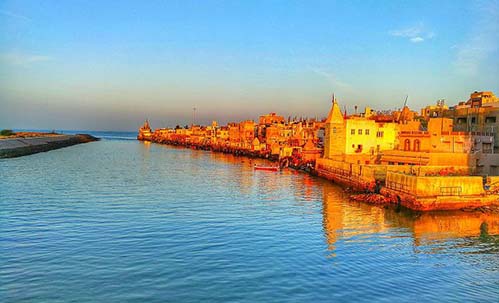
Beyt Dwarka is also known as Bet Dwarka or Bhent Dwarka and each of these names has a story associated with them.
Beyt or Bet in Gujarati means a space surrounded by water or an island. So the island that got cut off from Dwarka by water is called Beyt Dwarka.
Another legend associated with the name is that this is the place where Sudama – the poor friend of Sri Krishna came to meet him. Yes, the famous Krishna Sudama story took place here. You can hear the story inside the temple several times a day, every day. This story would make the name as Bhent Dwarka. Bhent means meeting, referring to the meeting of Krishna Sudama.
The place is also called Beyt Shankhodhar. Read the legend below on how it gets this name.
Gopi Talav
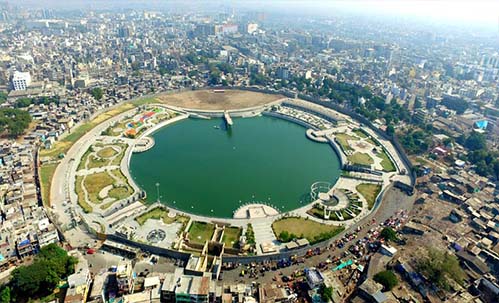
Gopi Talav is a lake in the Gopipura locality in Surat. It was built in circa 1510 CE by Malik Gopi, who was an affluent merchant and governor of Surat during the Mughal Empire. In 2012, the lake was renovated by Surat Municipal Corporation and the area surrounding it was redeveloped as a recreational facility.nice place to visit.
Places to Visit in PORBANDHAR with Short descriptions:
Kirti Mandir
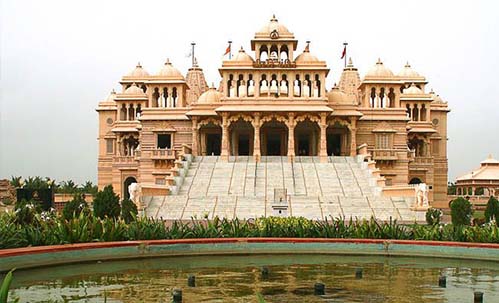
Let us begin our journey where Gandhi began his. On October 2, 1869, Mohandas Karamchand Gandhi was born in a 3-storey blue haveli in the city of Porbandar, where his father, uncle and grandfather had all been prime ministers to the Jethwa Rajput rulers of the princely state.
The site of Gandhi’s birth, now called Kirti Mandir, has been converted into a small museum about him, with an exhibit of old photographs, some of his very few possessions and a nice library of books either by him or relating to Gandhian philosophy and practice.
SOMNATH
Somnath, literally meaning 'lord of the moon' is a pilgrim center and is home to one of the 12 Jyotirlingas. It is a town which derives much of its identity from the mythology, religion, and legends that surround it.
Primarily a temple town, Somnath is a place where a strong scent of religion and legends lingers around tourism and even daily life. Its spiritual environment is ornamented by the huge number of temples in the area, however, Somnath also offers beaches, museums and other attractions. While the Somnath temple and Somnath beach are the primary places to visit here, Gita Mandir, Balukha Tirtha, Kamnath Mahadev Temple, Somnath Museum are some of the other places that one can visit.
Places to Visit in SOMNATH with Short Descriptions:
Bhalka Tirtha
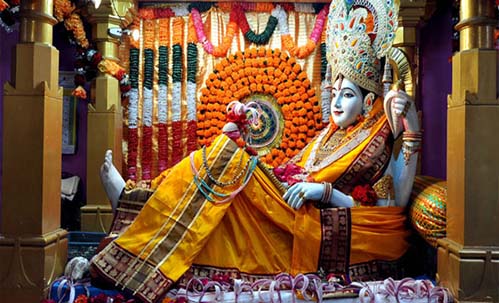
Bhalka Tirtha, located in the Veraval in Saurashtra on the western coast of Gujarat, India, is the place where Krishna was hit by an arrow shot by a hunter named Jara, after which he is said to have left the earth for the heavenly abode, an act referred to in the Puranas as Shri Krishn Neejdham Prasthan Leela.
Triveni Sangam/ Ghat
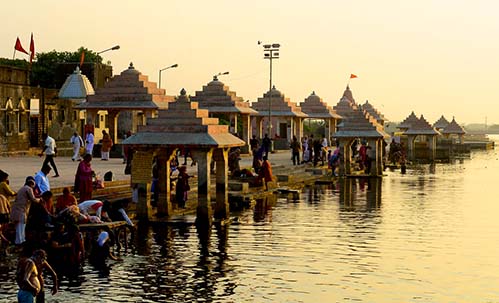
Also known as Triveni Sangam, Triveni Ghat is the meeting place of three rivers Hiran, Kapila and Saraswati and then empties together into the Arabian Sea. These stages of rivers where they meet and then flow together to the sea symbolize human birth, life and death. Triveni Ghat holds a significant place in the Hindu Mythology and Puranas and also finds a mention in the Hindu epics Ramayana and Mahabharata. It is believed that a bath at Triveni Sangam can wash off all sins and also facilitate Moksha by merging with the God.
As per Hindu mythology, this is the place visited by Krishna after being hit by an arrow and is considered to be the cremation ground of Lord Krishna. A temple has been dedicated to him to mark the place. This is also the place where the chhatri of the Lord Krishna is constructed. One can also pay a visit to the popular temples of Gita Mandir and Lakshmi Narayan temple that are located on the banks of the ghat.
Somnath Temple
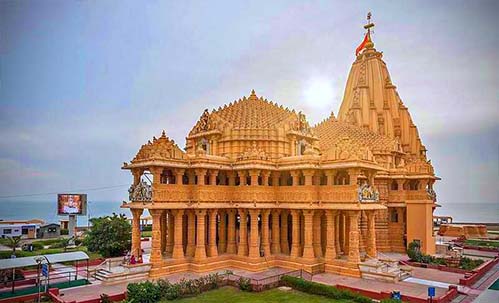
Shree Somnath is first among the twelve Aadi Jyotirlings of India. It has a strategic location on the western coast of India. Ancient Indian traditions maintain a close relationship of Somnath with release of Chandra (Moon God) from the curse of his father-in-law Daksha Prajapati. Moon was married to Twenty-Seven daughters of Daksha. However, he favoured Rohini and neglected other queens. The aggrieved Daksha cursed Moon and the Moon lost power of light. With the advice of Prajapita Brahma, Moon arrived at the Prabhas Teerth and worshipped Bhagvan Shiva. Pleased with the great penance and devotion of Moon, Bhagvan Shiva blessed him and relieved him from the curse of darkness. Pauranic traditions maintain that Moon had built a golden temple, followed by a silver temple by Ravana, Bhagvan Shree Krishna is believed to have built Somnath temple with Sandalwood.
The research based on ancient Indian classical texts show that first Somnath Jyotirling Pran-Pratistha was done on the auspicious third day of brighter half of Shravan month during the tenth Treta yug of Vaivswat Manvantar. Swami Shri Gajananand Saraswatiji, Chairman of Shrimad Aadhya Jagadguru Shankaracharya Vedic Shodh Sansthan, Varanasi suggested that the said first temple was built 7,99,25,105 years ago as derived from the traditions of Prabhas Khand of Skand Puran. Thus, this temple is a perennial source of inspiration for millions of Hindus since time immemorial.
The Moon God is said to have been relieved from the curse of his father-in-law Daksha Prajapati by the blessings of Bhagvan Somnath. In the Shiva Purana and Nandi Upapurana, Shiva said, `I am always present everywhere but specially in 12 forms and places as the Jyotirlingas`. Somnath is one of these 12 holy places. This is the first among the twelve holy Shiva Jyotirlings.
The later sources of history account for several desecrations by Muslims invaders during eleventh to eighteen century A.D. The temple was rebuilt every time with the reconstructive spirit of the people. The modern temple was reconstructed with the resolve of Sardar Patel who visited the ruins of Somnath temple on November 13 1947. Then President of India, Dr. Rajendra Prasad, did the Pran-Pratistha at the existing temple on 11 May 1951.
Other spots in the temple are Shri Kapardi Vinayak and Shri Hanuman Temple in addition to Vallabhghat. Vallabhghat is a beautiful sunset point. The temple is illuminated every evening. Similarly, the Sound & Light Show “Jay Somnath” is also displayed every night during 8.00 to 9.00, which allows the pilgrims an ethereal experience in the backdrop of grand Somnath temple and the holy wave sounds of the Ocean.
